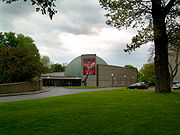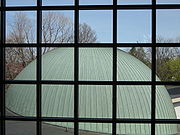
Strasenburgh Planetarium
Encyclopedia

Rochester, New York
Rochester is a city in Monroe County, New York, south of Lake Ontario in the United States. Known as The World's Image Centre, it was also once known as The Flour City, and more recently as The Flower City...
. It is named after its benefactors, Edwin and Clara Strasenburgh. It is a department of the Rochester Museum and Science Center
Rochester Museum and Science Center
The Rochester Museum and Science Center, or RMSC, is a museum in Rochester, New York that features many exhibits related to science. These include AdventureZone, the newly expanded Expedition Earth, How Things Work, and other traveling interactive exhibits, in addition to the permanent historical...
. The Planetarium was dedicated on September 14, 1968. The 65-foot-diameter Star Theater originally seated 240 people. The original seats were replaced in 1985; as currently configured, the theater seats 225. The Star Theater houses the first Zeiss Mark VI planetarium projector; it is still in daily operation. The planetarium received world-wide attention by being the first to be computer automated. It was known for both its technical and programming innovations.
History
In 1935, soon after the opening of major planetariums in Chicago, Philadelphia, New York and Los Angeles, Arthur C. Parker, Director of the Rochester Museum of Arts and Sciences (predecessor to today's Rochester Museum & Science Center), recommended construction of a planetarium in Rochester.
Pratt Institute
Pratt Institute is a private art college in New York City located in Brooklyn, New York, with satellite campuses in Manhattan and Utica. Pratt is one of the leading undergraduate art schools in the United States and offers programs in Architecture, Graphic Design, History of Art and Design,...
in Brooklyn, NY, included a detached planetarium building at the corner of East Avenue and Goodman Street, just west of the main Museum building. The conceptual plan also included a separate auditorium and a building for industry-related exhibits. None of these was actually constructed.
In the fall of 1964 the Rochester Museum of Arts and Sciences announced that it had received a gift of "more than one million dollars" from Mr. and Mrs. Edwin G. Strasenburgh of Rochester for the purpose of building a planetarium. The building design, by Carl F. W. Kaelber Jr. of the Rochester architectural firm of Waasdorp, Northup & Kaelber, was announced on June 28, 1966. In contrast to the 1959 concept, Kaelber's design placed the Strasenburgh Planetarium on the east side of the original Museum building. The Planetarium building was said to resemble a snail shell or a spiral nebula.
Construction began with a groundbreaking ceremony on March 16, 1967. The building was dedicated on September 14, 1968.

